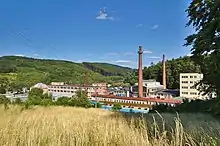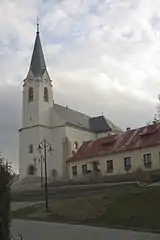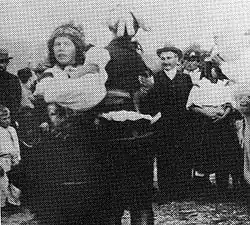Strání
Strání is a municipality and village in the Uherské Hradiště District in the Zlín Region of the Czech Republic. It has about 3,500 inhabitants. It is located directly on the border with Slovakia.
Strání | |
|---|---|
 General view of Strání | |
 Flag  Coat of arms | |
 Strání Location in the Czech Republic | |
| Coordinates: 48°54′8″N 17°42′24″E | |
| Country | |
| Region | Zlín |
| District | Uherské Hradiště |
| First mentioned | 1318 |
| Area | |
| • Total | 39.75 km2 (15.35 sq mi) |
| Elevation | 418 m (1,371 ft) |
| Population (2020-01-01[1]) | |
| • Total | 3,474 |
| • Density | 87/km2 (230/sq mi) |
| Time zone | UTC+1 (CET) |
| • Summer (DST) | UTC+2 (CEST) |
| Postal code | 687 65, 687 66 |
| Website | www |
Administrative parts
Village of Květná is administrative part of Strání.
Etymology
The Czech word strání translates into English as "slopes", and the moniker is indicative of the fact that the municipality (418 meters above sea level) is nestled in a valley of the White Carpathian Mountains.
History
Strání is located in an ancient mining area and an apparent settlement area of the Stone Age Corded Ware Culture (2900–2350 B.C.). In the 11th and 12th centuries the area Strání was on the so-called Hungarian Way. This road was used by Bohemian troops as they marched to attack the Turks and Tatars in Hungary. After the mid-13th century it became an important commercial link between Hungary and Czech lands. The first written mention of Strání is from 1318. By 1359, Strání was referred as a market town for the first time. In 1483, tolls were collected in Strání for the upkeep of the commercial road, and by 1492 Strání included 44 houses and 2 mills.[2]
In 1502, John Bernard of Kunovice conquered the area, including Strání, and his family maintained dominion over Strání until the Battle of White Mountain in 1618, when the Bernards lands were confiscated by the Emperor because the family supported the failed rebellion against him. In 1625, the Bernardi land holdings were sold to the Lichtenstein family, which maintained ownership of Strání until 1945.[2] Until 1943, there was a thriving Jewish community in Strání, but in that year the Nazis deported all known Jewish Stránaci to the Theresienstadt concentration camp. Even so, several buildings in Strání are still architecturally ornamented with the Star of David. One such example can be found on the rear façade of Sklípek, a local bar.
Infrastructure
The municipality of Strání is home to two post offices, one in the Strání village and one in the village of Květná. There are two kindergartens and a primary school in the municipality.
Economy

Central to the stability and future growth of Strání are the two largest employers in the municipality, the Květná Glass Works and the manufacturing company Santra. In 1794, the Lichtensteins, thanks to beech forests, high-quality glass sand and the close proximity of an important trade route to Hungary, chose Strání as the location of a glass works. Glass production began in the summer of 1795 and has been continuous since that time. In 1897 Květná was only the second glass factory in Europe to introduce etched glass production.[3] Today, Květná produces only sodium potassium glass using traditional blowing and hand-shaping methods and ladle furnaces. It employs about 180 people. Santra, headquartered adjacent to Zámeček, manufactures a wide variety of park furnishings and storage solutions and employs about 50 locals.
Sights

The Catholic Church of the Exaltation of the Holy Cross is in the centre of Strání. The parish church was first commissioned by Prince Wenceslas von Lichtenstein in 1748 and was built with material taken from the ruins of a fortress. But the original church was too small and the church belfry damaged by lightning, so the Lichtenstein church was ultimately demolished and replaced with a new, larger church, constructed in the Neo-Gothic style and consecrated in 1911.
Nearby the church is Štrbákovec, a 19th-century house that is home to a small cultural museum, which is a national historic landmark.
Also near the church is Zámeček, a two-story château with vaulted ceilings throughout that was constructed in the late-16th century, expanded upon in the mid-17th century, renovated in the mid-19th century and renovated again in 2011. The Lichtensteins owned Zámeček from the 17th century until 1948 when the building was nationalized.
Cultural references

In Leoš Janáček's opera The Cunning Little Vixen, the priest moves to Strání, expressing the hope that life will be better there. It is one of the only two place names mentioned in the opera (the other being Brno).[4]
Notable people
- Ondřej Benešík (born 1976), politician; lives here
References
- "Population of Municipalities – 1 January 2020". Czech Statistical Office. 30 April 2020.
- "Historie". strani.cz (in Czech). Obec Strání. Retrieved 6 October 2020.
- "History". cervabohemia.co. Cerva Bohemia s.r.o. Retrieved 6 October 2020.
- The Cunning Little Vixen. Dir. Brian Large. Châtelet Théâtre Musical de Paris, 1995. DVD. Image Entertainment, 1999.
- "Strani - Unsere mährische Partnergemeinde". euratsfeld.gv.at (in German). Gemeinde Euratsfeld. Retrieved 6 October 2020.
| Wikimedia Commons has media related to Strání. |